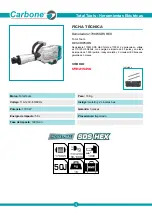
Fitting Sanding Paper
1. The sanding pad must first be fitted to the
spindle following the instructions in the
previous section.
2. Press the sanding paper onto the sanding pad
by aligning the edges and holes.
3. To remove, peel away from the sanding pad
starting from an edge.
Sanding
With the sanding pad and sand paper fitted, the multi function tool can be
used on materials such as wood, plastic and painted surfaces.
1. Ensure the accessory is secure,
and then start the tool.
2. Place the multi function tool
flat on the workpiece and
make smooth back and forth
movements.
Note:
Do not apply heavy pressure to the tool or tilt the sanding base as
this will wear out the sanding paper and may damage the sanding pad.
Sandpaper Selection
Selecting the correct grit of sandpaper is an important step in achieving
optimum results. Coarse grit will remove the most material. Finer grit will
produce a smoother finish. The condition of the workpiece will determine
the grit of the sandpaper to be used. The higher the grit number, the finer
the grade of sandpaper.
If the surface is rough, start with a coarse grit and sand until the surface
is uniform. Medium grit may then be used to remove scratches left by the
coarser grit. Finer grit is then used to finish the surface. Always continue
sanding with each grade of sandpaper until the surface is uniform.
MATERIAL
APPROPRIATE GRIT
Coarse
Sanding
Fine
Sanding
Paintwork
180
400
Wood:
Softwood
60
240
Hardwood
60
180
Veneer 240
320
Note:
If intermediate sanding is required, choose a grit rating between
coarse and fine. The above table is intended as a guide only. To ensure a
satisfactory result, a small, inconspicuous area should first be tested to
ensure the grit of sandpaper chosen is suitable for the desired finish.
Sawing Or Cutting
When sawing, the multi function tool can be used on wood, plastic and
sheet metal using the correct accessory.
Note:
Ensure blades are not blunt or damaged in any way before
commencing.
1. Ensure the work piece is securely held down
and the accessory is secure.
2. Switch the tool on use a slight
pendulum motion while cutting.
Scraping
When being used as a scraper, the tool can remove materials such as fabric,
adhesives, vinyl or paint from wood, plastic and metal.
1. Ensure the accessory is secure, and then start
the tool.
2. Hold the tool at an angle of 10°-
15° to the workpiece.
Note:
Allow the scraper to do the work; do not apply heavy pressure to
the tool. This may cause the multi function tool to overload or cut into the
surface of the material.
4. SANDING
5. SAWING & SCRAPING
10° - 15°
PXMFTS-018
























